You’ve got your bowl of popcorn in your lap and your phone on airplane mode, your blanket is pulled up and you’re about to dive into a new series. You watch an episode, then another, and 36 hours later—you've finished binge-watching three seasons. You are fulfilled, and there’s not a single regret about how you’ve spent your time. Whether it’s Stranger Things, GoT, or Wednesday, we’ve all been there.
This is exactly how user activation works for SaaS products. When users sign up for your app, they explore your interface and features with the same excitement and keenness as watching a pilot episode of a new show. Once the pilot is over, it's entirely on the appeal of your user experience and product functionality to keep them hooked; to keep that popcorn flowing.
Activation rate measures the percentage of users who go beyond onboarding flows to complete all key activation milestones and find real value in your product.
This article will give the nuts and bolts on activation rates and five proven tactics to boost them. Let’s get those users binging on your product.
Activation rate is a measure of how many users have performed pre-defined actions to realize the product's value to them
User activation takes customers from a state of doubt and confusion about the product to a complete mastery of the tool
There’s no fixed benchmark for a good activation rate because it depends on multiple factors, primarily the ease of performing the activation tasks
Testing your assumptions about what might make users tick is a surefire way to establish clear activation milestones and achieve more success
What is the activation rate in SaaS?
The activation rate indicates the number of users who have completed critical milestones within your product. These milestones are core actions that demonstrate your product's true value, eventually leading users to peak engagement levels when they become ‘activated.’
Typically, these milestones focus on building habits around a product feature. So, when users complete these milestones and get activated, they become more habitual in using your app for specific needs. This naturally boosts retention, making user activation one of the biggest growth levers for all SaaS companies.
User activation shows users your product's core capabilities through a series of events and action points. This can be in the form of onboarding flows for new users or new feature adoption milestones for existing users.
Whatever the case, the activation rate measures the impact of your efforts.
How to measure your activation success?
SaaS companies measure user activation rates by tracking the number of users completing a series of pre-defined milestones in a given period.
To do this, you need to lay down your activation milestones first. Then track user behavior to calculate the percentage of users completing all these events in the specified timeline.
Here’s a simple formula to get the exact activation rate percentage.

You can also measure the activation rate for different user personas, segments, and cohorts to identify the scope of improvement in your activation process for different types of users.
What makes a good activation rate?
There's no standard benchmark for a good activation rate. It differs based on the niche, product type, business model, and other factors. However, we can go by research to narrow down a good activation rate to a bracket of 20-40%.
OpenView Partners’ benchmarking survey concluded that the activation rates for the top PLG companies stood at 20-40%
Lenny Rachitsky and Yuriy Timen’s independent benchmarking survey of over 500 companies kept the average activation rate for SaaS products at 36%
Milestones are one of the biggest factors affecting user activation rates. Easier activation milestones = higher activation rates. So, it can be easy for SaaS to have an impressive activation rate in their reports if their milestones are not necessarily ‘mile-long.’
You don't have to limit your users to low-lift action points to boost activation rates, in fact, it’s better if you don’t. You can maximize your activation success organically with a strong strategy, in-app messaging, and making decisions backed by data (more on this later).
Activation rate vs. Time-to-value: What's the difference?
Activation rate shows SaaS teams how effectively they’re helping users understand and internalize the product’s value. It’s a milestone-based metric that focuses only on the number of users who have completed all key tasks that your product team deems as necessary for your product to become a habit.
Research from UCL found that, on average, it takes someone 66 days (attempts) to build a habit. Now, it’s worth noting that this research spectrum spanned from 18-254 days. So, although this is a good idea to keep in mind, it’s not the be-all and end-all of habit building, and you’ll want to form your own hypothesis from the in-app actions of those users with the highest CLTV.
On the other hand, time-to-value calculates the time it takes users to realize the product's full value. Put simply; it tracks the time taken from the sign-up or trial period to the "aha!" moment. It's purely time-based and doesn't factor in any milestones. This is typically shorter than your activation timeline, although not always!
For example, this is what the visual representation of the onboarding success criteria and users realizing the product’s value would look like for Slack, as explained by ProductLed.
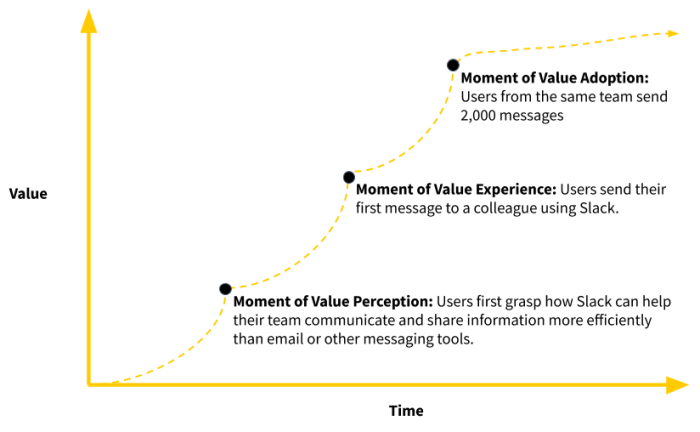
(Source: ProductLed)
A high activation rate implies more engaged users and incoming higher retention rates. A high time-to-value indicates a flawed onboarding flow, with users taking too long to experience your product's benefits.
So, the main difference between these product KPIs is how they evaluate user behavior—activation rate measures milestone-based actions, and time-to-value measures timeline-based behavior.
Increase activation rate with these five tactics
If you’re a product manager trying to keep users hooked to your app, follow these five tactics to increase your user activation rates and turn your users into product-binging fans.
1. Set clear activation milestones for different user segments
Your activation success is closely hinged on your activation milestones. Measuring activation would be counterproductive if your milestones are low-effort and don't showcase your product's value to specific user groups.
Instead, establish clear, research-backed activation milestones tailored to your diverse user personas.
For example, if you offer a product for teams and individuals, your activation tasks should differ for these two personas based on their needs and the jobs to be done.
So, how exactly do you set these milestones? By tracking user activity and analyzing all key in-app events users took to lead them to a long and prosperous in-product life.
This will help you figure out specific actions that change the game for specific user types and help you develop strategies to make more people within the same group of users stick to your product.
🎬 Webinar Recording: 6 Ways to Collect and Apply User Feedback to Improve Your Product
2. Optimize onboarding flows for higher activation
You can consistently activate customers by optimizing your onboarding flows using the right customer onboarding tools for greater user success.
The onboarding sequence is the ideal time to show new users exactly what your app can do for them and the outcomes they can create. Use this opportunity to make a strong impression on your users by targeting their exact pain points.
Remember: Creating onboarding flows isn’t a one-and-done process. You need to consistently review, iterate, and optimize this process based on your users’ inputs.
Here’s how you can optimize the onboarding experience:
Collect user feedback: Ask users for their thoughts on the onboarding experience, if they faced any challenges or would like to change anything
See what’s working: Analyze user behavior to review your onboarding flows’ effectiveness and double down on what’s successful
Optimize for “aha!” moments: Use journey maps to understand how each user persona navigates your product, and lead them to their aha! moments with better onboarding flows
For example, RemoteBase personalizes its welcome screen and dashboard for all users with a short series of prompts when users sign up. This lets users clarify exactly what they want and helps you categorize them into an accurate user segment from the start.
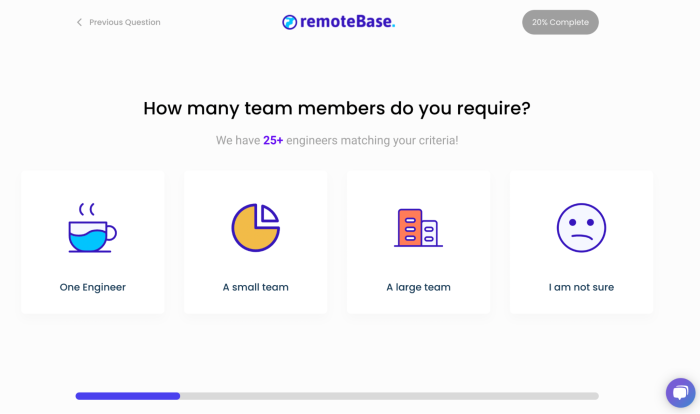
(Source: RemoteBase)
3. Create customized milestone messaging
Getting new sign-ups is only half the battle. The other half is about convincing these new users to go for a paid plan once their trial period is over. How? Through milestone-based messaging.
Milestone-based messages are in-app notifications triggered at different points in a user’s activation flow. These messages nudge users to complete an action, reach their desired goals, and get closer to activation.
Here’s a visual representation of a product maturity funnel and the milestones within.
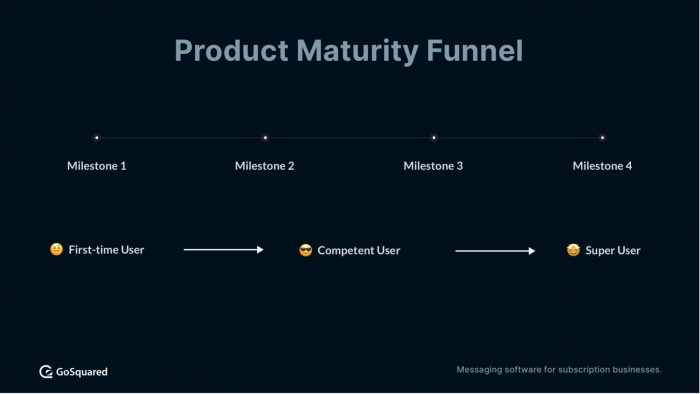
(Source: GoSquared)
And here are a few milestone messages you can set up to boost activation rates.
Sign-up and welcome: Give users a quick reminder to complete the onboarding flow and set things up on the app, like building their profile, uploading data, or integrating any tools
Acknowledge wins: Celebrate user behavior when they perform key tasks or use a new feature
Explain complex features: Show your support when users get stuck or face difficulty with advanced product features
Free trial expiry: Send a quick nudge to remind users when their free trial period is about to expire and they need to renew their plan
Milestone in-app messages aim to reiterate your key tasks to activate customers more effectively and quickly. You can also set up email messages to remind users about upcoming payments, send them weekly/monthly round-ups of their performance, or reconnect with disengaged users. It reiterates your product value and boosts engagement, even if your users are not actively in the app.
4. Validate your assumptions with product analytics
You can’t base your activation process on guesswork. You need to think from the users’ perspective and validate your assumptions about user behavior to set meaningful activation milestones.
To do this, you can use a product adoption platform like Chameleon to ask users directly about their feedback with in-product surveys.
Additionally, if you already have a product analytics tool like Mixpanel, Heap, or Amplitude in your tech stack, use bi-directional integrations between these tools to test any assumptions, understand their validity, and get deeper insights about user activation.
For example, your assumptions could be:
"We think users who see a Tour X will activate more quickly than users who see Tour Y."
"We think that users who see Tour Y will understand how a particular feature works and how to get the value from it for their use case."
"We think that free-trial users who see Tour Z will activate faster, engage more deeply with the product, and become paying customers before the trial ends."
Configure each of these assumptions into separate tours and define your experiment criteria. This will help you understand whether your cohort analysis and user behavior data will confirm or deny assumptions.
This analysis will clarify whether your onboarding flow is designed to help users perform all essential tasks or it’s missing the mark. You can then dig deeper into it to understand the impact of every tour (X, Y, Z) you’re running. For example, with Chameleon, you can track the performance of your Tours on the Dashboard, and it would look like this 👇
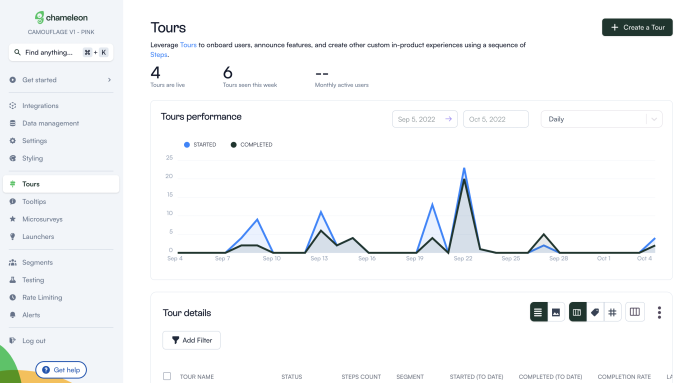
5. Learn from the insights and apply changes
Once you get your experiment results, you can go into more detailed views to uncover more insights into your activation, engagement, and adoption metrics. For example, you could see how many people have completed the activation tasks from start to finish in the past 30 days. Then, match that with upgrades or usage rates.
For this last step, carefully analyze all the insights gained from your user behavior test results. This assessment will help finalize activation milestones that prevent users from dropping off and bring them back for more product experiments and optimization opportunities. More users = more tests!
Consistently review how your milestones perform and gradually introduce new milestones to different user cohorts. This is important to test the effectiveness of newer milestones before rolling them out to your entire user base.
Rinse and repeat strategies that work for you to keep bringing in results.
Activate more users quicker than ever before
At its core, user activation is about showing users how effectively your product can solve their pain points.
To ramp up your activation rate and turn users into product champions, you need to identify their aspirations, tie them to a product feature or action, and establish solid activation milestones to get there.
Users who complete these milestones will likely perceive your product value better and will willingly upgrade to a paid plan or stay around for longer—increasing your customer lifetime value (LTV).
That’s what makes activation rate a huge growth lever for SaaS companies. After all, the more activated customers you have, the greater retention and higher customer satisfaction you can expect—which feeds itself into a growth loop for your SaaS.
It’s time to keep that ‘popcorn’ flowing and your users happy spending their time with your product.
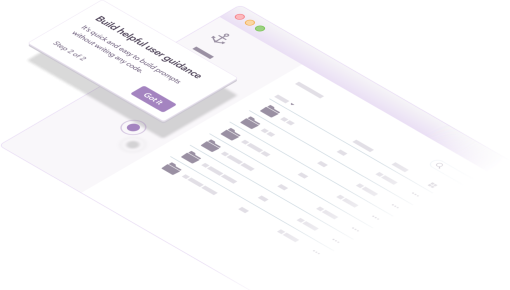
Boost Product-Led Growth 🚀
Convert users with targeted experiences, built without engineering




